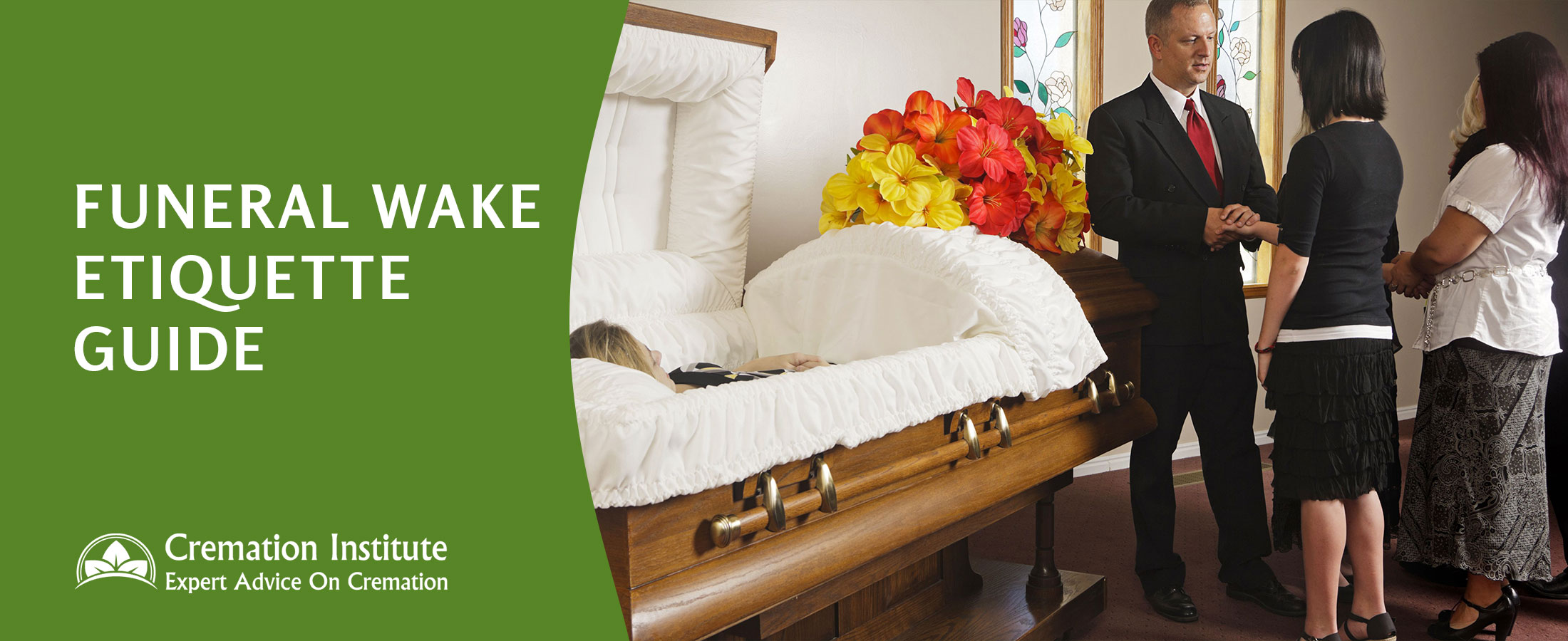Funeral Wake Etiquette Guide: 5 Surprising Things To Expect


Written by Amy Gardner: Grief & Memorial Expert
 Reviewed by Adam Binstock On July 11, 2020
Reviewed by Adam Binstock On July 11, 2020
Article Highlights
What Is a Funeral Wake? What Is a Viewing? What Happens At a Wake Common Questions What To Wear Funeral Wake EtiquetteThere are so many words and ways to describe our rituals of saying goodbye.
What do they mean? What happens during them? And how should we behave?
If you’re planning to attend a wake, you may be wondering what you’re in for.
In this funeral wake guide, I’ll help you understand what to expect.
What Is a Funeral Wake?
The words “wake” and “visitation” are often used interchangeably.
They usually describe that part of a traditional funeral in which loved ones spend time in the presence of the remains of the deceased person.
However, the word “wake” has its roots in older traditions in which friends and loved ones gather in a private home to watch over and pray for the body.
What Is a Viewing?
Unlike wakes, a viewing almost always takes place in a funeral home.
Even in the rare case that a viewing is held in a private home, it still has a more formal tone than a wake.
While wakes are an old tradition, viewings are more modern, designed with the services of modern-day funeral home directors and morticians in mind.
What Happens At a Wake
A wake is a highly individualized ritual. It varies depending on the characteristics and personality of each individual and their family.
The community and culture of the place you live also make a difference to the personalization of this unique ritual.
However, there are a few universal customs you can depend on.
Visiting The Body
During a traditional visitation or wake, it’s customary for the body to be displayed in an open casket.
Visitors approach the body to pay their respects and say goodbye.
This is considered to be a way to honor the deceased person and to get closure.
People can even touch the body if they find this to be comforting.
Greeting The Family
The primary purpose of a wake is to offer comfort to the family members.
In some cases, there may be a formal receiving line for you to walk through to give your respects.
Or, in a more informal atmosphere, this may involve simply sitting down with the family and sharing condolences and memories.
The Atmosphere
If you are accustomed to a formally structured funeral service, with songs, eulogies and scripture, the unstructured atmosphere of a wake might take you off guard.
Rather than having one person/speaker as a focal point to the gathering, expect people to gather casually in small groups.
Unlike a traditional funeral, there is no expectation regarding how long you should stay. Instead of staying to the end, you are free simply to drop by for a while and pay your respects.
Remembering The Deceased
In contrast to other kinds of post-death rituals, the focus of a wake is on sharing positive memories of the deceased person.
This can be valuable in helping mourners move away from the pain of grief and into a more positive frame of mind, remembering interactions that made them feel happy.
Common Questions
If you have been invited to attend or participate in a wake, you may be curious about what you can expect, especially if you have never attended one before.
Here are the answers to a few common questions.
How Long Does a Wake Last?
Traditionally a wake is held in the evening before a funeral service.
It can last anywhere from two hours to six.
The length often depends on how many people are expected to attend.
What Do You Bring To a Wake?
Unlike funerals, it is not traditional to bring flowers to a wake. This adds stress to the family who may be unsure of what to do with them when they arrive. However, you can always have flowers sent ahead of time to the funeral home.
In the same vein, while cards and small gifts are always appreciated, it is better to send them to the family separately rather than bringing them to the wake.
However, if you have a practical gift, especially if it’s a casserole for the family or appetizers that people can munch on during the event, this will usually be welcome at a wake.
How Long Should You Stay At a Wake?
This is completely up to you.
If you are hoping to catch up with other friends and family members to show your support, this is a good time to do so.
However, it is perfectly acceptable to leave immediately after paying your respects to the family.
It’s all down to your comfort level and what you need to do to find a sense of closure.
Should a Child View an Open Casket?
If there is going to be an open casket, be sure to explain to your child ahead of time so he/she knows what to expect.
Tell the child that it’s fine to touch a loved one’s body if they want to, but don’t make them feel that they must do so if they’re uncomfortable with it.
Is It OK If I Wear Jeans To a Wake?
As a society, we have become much more relaxed than we used to be about dressing up.
Jeans are acceptable in all kinds of places where they never were before: religious services, airline flights, even our jobs.
But when it comes to post-death rituals such as funerals and wakes, dressier outfits are still expected.
In general, jeans should be avoided unless you have nothing else to wear.
However, if you do not own anything dressier than jeans, it is better to go anyway. Do not avoid going simply because you don’t have any dressy clothes.
Do I Have To Wear Black To a Wake?
There’s no need to dress entirely in black.
However, darker or muted colors are more respectful for the occasion.
What To Wear
Wakes tend to require less formal clothing than other traditional rituals, like funerals.
In general, stick with neutral or muted colors.
Avoid anything ostentatious or showy; keep it simple.
Try to stay away from bold prints, and stick with comfortable dress shoes.
Here are a few other guidelines regarding dress.
Men
A suit is always a good choice for men to wear at a wake.
Alternatively, you could also wear a sports coat, button-down shirt, tie and dark pants, dark socks and dress shoes.
Dark pants with a polo shirt is also a good choice.
Wear a belt and avoid flashy or excessive jewelry.
Also stay away from athletic shoes, flip-flops, baseball caps, or any clothing with words or graphics.
Women
For women, conservative attire is best.
A solid-colored dress in a muted color, accompanied by dark shoes, is always a good choice.
A dark skirt paired with a formal topo also works.
But you don’t have to wear a skirt or dress. A pair of dress pants with a dressy top is perfectly acceptable.
Children
The rules regarding proper attire for children are much more relaxed that what is expected of adults.
In general, you should try to dress them formally. However, this is not always possible for young children, who grow quickly and may not have access to dressy clothes.
Avoid casual hats or clothing with words on it.
Funeral Wake Etiquette
Funerals and wakes are the kind of occasion in which manners are important.
Although an informal occasion in many ways, there still exists an unwritten code of etiquette for funeral wakes.
Here’s what you need to know.
Who Should Attend
Like funerals, wakes are usually open to the public, especially if they take place in a funeral home.
Wakes that are announced either online or in an obituary are open to anyone, including coworkers and casual acquaintances.
However, the rules are slightly different if the wake is held in a private home. In this case, it’s best to only attend if you receive an invitation.
What To Say To The Family
Only you know what kind of relationship you have with the family members or what you might be comfortable saying to them during their time of loss.
Sharing stories and memories about the deceased person is always appropriate and appreciated.
In general, steer clear of well-meaning platitudes. Everyone experiences loss differently, and a misguided opinion or insight may cause more harm than good.
What To Bring
An edible gift (think fruit baskets, sandwich plates or baked goods) is always a good thing to bring to a wake, especially if it’s held in a private home.
Cards can also be brought with you to a private wake.
What Not To Do
First and foremost, be careful not to say or do anything that puts pressure on the bereaved. Even a seemingly kind remark like, “Call me if you need anything” puts the burden of reaching out on the family, pressuring them to think of ways that others can help.
Also don’t post any photos or video of the wake on social media. No matter how well-attended it is, a wake is essentially a private event.
Phone
Limit your phone use as much as possible during the wake.
Texting durng the wake can seem disrespectful. It’s also taking away from the time you’ve devoted to spend with friends and family that you might not otherwise see very often.
Punctuality
Unlike a funeral, you can show up to a wake whenever it’s convenient.
One caveat: try to make sure you’re there at least a half hour before the wake is scheduled to end.
Showing up just as the wake is wrapping up is disrespectful to the grieving family.
Leaving
As long as you have paid your respects to the family, it is acceptable to leave at any time.
Make sure that you go through the receiving line first and speak to each person in it, even if you don’t know them well.


I think this is helpful — but perhaps the receiving line: could you add some additional explanation of what that is and what is expected? I know from attending some wakes and funerals that this is sometimes a surprise to attendees, especially those who only knew the deceased and find the unexpected encounter with the family to be unnerving.
What if the person who passed was angry at you? You were kept from hospital visit “so not to stress paitent”, they died, no final resolution or forgivness, Oh and they your father!
The new wife kept you apart because she threatend you may contest the will? its a dusy of a question I know. What ceremonys is it appropriate to attend? Help!!